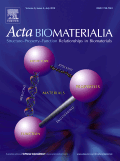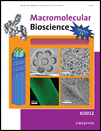
Frontiers in Bioengineering and Biotechnology
Scope & Guideline
Driving Breakthroughs in Biomedical Engineering and Beyond
Introduction
Aims and Scopes
- Tissue Engineering and Regenerative Medicine:
Research in this area focuses on developing scaffolds, hydrogels, and biocompatible materials that support cell growth and tissue regeneration. Key studies often explore the integration of stem cells and bioactive compounds to enhance healing and regeneration processes. - Nanotechnology Applications:
The journal highlights the use of nanomaterials and nanotechnology in various biomedical applications, including drug delivery systems, imaging techniques, and therapeutic strategies for cancer and other diseases. - Biomaterials Development:
Research on the design, synthesis, and application of novel biomaterials for medical devices, implants, and drug delivery systems is a core focus. This includes studies on biodegradable polymers, hydrogels, and composite materials. - Bioprocess Engineering and Biotechnology:
Papers often explore the optimization of bioprocesses for the production of biopharmaceuticals, biofuels, and other value-added products, emphasizing sustainable practices and the use of microbial systems. - Biomechanics and Biomechanical Engineering:
This area encompasses the study of mechanical properties of biological tissues and the design of devices and systems that interact with biological systems, including exoskeletons, prosthetics, and orthopedic implants. - Synthetic Biology and Genetic Engineering:
Research in this scope includes the manipulation of genetic material to enhance the production of desired compounds or to develop novel therapeutic strategies, often utilizing CRISPR technology and other genetic tools.
Trending and Emerging
- 3D Bioprinting and Biofabrication:
There is a growing trend in research focused on 3D bioprinting technologies and biofabrication methods for creating complex tissue structures, which are essential for regenerative medicine and tissue engineering applications. - Smart Biomaterials and Responsive Systems:
Research on smart biomaterials that respond to environmental stimuli, such as pH, temperature, or light, is gaining traction. These materials are pivotal for controlled drug delivery and dynamic tissue engineering. - Microbiome and Health Interactions:
The exploration of microbiome interactions with human health, particularly in relation to disease prevention and treatment, is an emerging area of interest that is leading to innovative biotechnological applications. - Personalized Medicine and Therapeutics:
There is an increasing focus on personalized medicine, including the use of patient-derived cells and tailored therapies, to enhance treatment efficacy and minimize side effects in various diseases. - Environmental Biotechnology:
Research addressing sustainable practices through biotechnological applications, such as bioremediation and waste valorization, is on the rise, reflecting a global focus on environmental health and sustainability. - Artificial Intelligence in Biotechnology:
The integration of artificial intelligence and machine learning techniques in biotechnological research is emerging as a significant trend, enhancing data analysis, predictive modeling, and optimization of bioprocesses.
Declining or Waning
- Traditional Biochemical Pathways:
Research focusing solely on traditional metabolic pathways without integration into broader systems biology approaches appears to be declining, as newer methodologies emphasize holistic and systems-level analyses. - Non-Biocompatible Materials:
There has been a noticeable decrease in studies involving non-biocompatible materials, as the field increasingly prioritizes the development of biocompatible and biodegradable alternatives for medical applications. - Basic Laboratory Techniques:
Papers centered on basic laboratory techniques and methodologies without significant innovation or application to bioengineering challenges are appearing less frequently, as the journal aims to publish cutting-edge research. - Agricultural Biotechnology Without Environmental Considerations:
Research addressing agricultural biotechnology that does not consider environmental impacts or sustainability is waning as interdisciplinary approaches that integrate environmental science gain traction.
Similar Journals

BIOCELL
Pioneering Discoveries in Molecular BiologyBIOCELL is a distinguished peer-reviewed journal dedicated to the field of Cell Biology, published by TECH SCIENCE PRESS. Since its inception in 1995, the journal has been at the forefront of disseminating innovative research, with converged publication years extending from 1995 to 2013 and from 2015 to 2024. Although it currently holds a Q4 ranking in the Cell Biology category according to the 2023 category quartiles, BIOCELL aims to foster advancements by providing a platform for researchers, professionals, and students to share their findings in biochemistry, genetics, and molecular biology. The journal is available in both print (ISSN: 0327-9545) and digital formats (E-ISSN: 1667-5746) and seeks to attract contributions that enhance scholarly dialogue and understandings of cellular mechanisms and innovations. With a commitment to quality research and critical discourse, BIOCELL plays an important role in nurturing the scientific community within Argentina and beyond, offering vital insights that contribute to the advancement of the life sciences.

Journal of Biological Engineering
Empowering Research in Biomedical and Environmental EngineeringJournal of Biological Engineering, published by BMC, stands as a prominent Open Access journal since 2007, dedicated to advancing the interdisciplinary field of biological engineering. With an ISSN of 1754-1611, this UK-based journal aims to provide a platform for researchers and professionals to disseminate innovative and impactful research across various domains including Biomedical Engineering, Environmental Engineering, Cell Biology, and Molecular Biology. The journal's notable rankings in the 2023 category quartiles exemplify its position within the scientific community, featuring Q2 status in Biomedical Engineering and Environmental Engineering, along with Q3 in Cell Biology and Q2 in Molecular Biology. By maintaining robust Scopus rankings and ensuring free access to cutting-edge research, the Journal of Biological Engineering plays a crucial role in driving discovery and collaboration among scholars, thereby enriching both the academic landscape and applied sciences.

Current Opinion in Biomedical Engineering
Fostering collaboration in cutting-edge bioengineering.Current Opinion in Biomedical Engineering is a renowned journal published by Elsevier, focusing on the cutting-edge developments and critical assessments in the fields of biomedical engineering and related disciplines. With an ISSN of 2468-4511, it provides a valuable platform for researchers and professionals to disseminate their insights and discoveries in areas such as bioengineering, biomaterials, and medicine. Its impressive impact factor positions it in the Q2 category for several fields, including Bioengineering and Biomedical Engineering, highlighting its influence and relevance in ongoing scientific dialogues. The journal’s unique format of opinion pieces and reviews encourages innovative thinking and fosters collaboration among experts. As an essential resource for those engaged in the life sciences and engineering, Current Opinion in Biomedical Engineering serves to stimulate discussion, promote knowledge exchange, and drive advancements in biomedical applications. Set in the Netherlands at Radarweg 29, 1043 NX Amsterdam, the journal is accessible through various academic platforms, enabling a global readership to engage with the latest scholarly work in this dynamic field.

Acta Biomaterialia
Innovating at the Intersection of Biology and EngineeringActa Biomaterialia, published by Elsevier Science Ltd, is a leading journal in the fields of biochemistry, biomaterials, biomedical engineering, biotechnology, and molecular biology. With an ISSN of 1742-7061 and an E-ISSN of 1878-7568, this prestigious journal has secured a remarkable position in the academic community, evidenced by its inclusion in the Q1 category across multiple disciplines for 2023. It ranks impressively at #21 in biochemistry, #16 in biomedical engineering, #18 in biotechnology, and #11 in biomaterials, reflecting its high impact and relevance to ongoing research and development. The journal provides a platform for disseminating innovative research and advancements in the design and application of biomaterials, contributing to scientific discussions that propel the field forward. Although it does not currently offer open access options, Acta Biomaterialia continues to attract contributions that advance our understanding of biomaterials and their interactions with biological systems, ensuring that researchers, professionals, and students remain informed about the latest trends and breakthroughs in this rapidly evolving area of study.

Advanced NanoBiomed Research
Transforming Ideas into Biomedical SolutionsAdvanced NanoBiomed Research is a pioneering open-access journal committed to advancing the interdisciplinary field of nanobiotechnology, published by WILEY-V C H VERLAG GMBH. Since its inception in 2021, this journal has provided a platform for innovative research that bridges the gap between engineering, medicine, and materials science. With impressive rankings in Scopus, positioning it within the top quartiles of various categories, Advanced NanoBiomed Research aims to disseminate high-quality research that contributes to the understanding and application of nanomaterials in biomedical contexts. As it encompasses a wide scope—from applied microbiology to biomaterials—it serves as an essential resource for researchers, professionals, and students eager to explore the cutting-edge developments in the field. The journal promotes a collaborative environment where emerging ideas can flourish, ensuring that vital advancements in nanobiomedicine can be shared and built upon within the scientific community.

Advanced Biology
Pioneering Innovations in Life SciencesAdvanced Biology, published by WILEY-V C H VERLAG GMBH, serves as a premier platform where innovative research and scientific breakthroughs in the fields of biochemistry, genetics, and molecular biology converge. Established in 2021, this journal has rapidly ascended to prominence, securing Q1 rankings in its primary categories, including general biochemistry and biomedical engineering, and a solid Q2 ranking in biomaterials. With an ISSN of 2701-0198 and an emphasis on open access, Advanced Biology ensures that rigorous peer-reviewed research is accessible to a global audience, enhancing visibility and fostering collaboration among researchers, professionals, and students alike. By 2024, it aims to continually elevate scientific understanding and innovation, catering to the growing interdisciplinary nature of these critical fields. With Scopus rankings placing it amongst the top quartiles in its disciplines, Advanced Biology is poised to make significant contributions to the future of life sciences.

MACROMOLECULAR BIOSCIENCE
Unveiling New Horizons in Biomaterials and BioengineeringMACROMOLECULAR BIOSCIENCE, published by WILEY-V C H VERLAG GMBH, is a leading journal in the fields of bioengineering, biomaterials, biotechnology, materials chemistry, and polymers and plastics. With a convergence of scientific inquiry since its inception in 2001, the journal has established itself as a vital resource for researchers and professionals exploring the interface of molecular sciences and biosystems. It boasts impressive Scopus rankings, including Q1 status in multiple categories, reflecting its significant contribution to advancing knowledge and innovation in the polymer and biomaterials domains. While the journal does not currently offer open access options, its rigorous peer-review process ensures the publication of high-quality research that fuels academic discourse. Positioned in Weinheim, Germany, MACROMOLECULAR BIOSCIENCE aims to bridge theoretical understanding with practical applications, making it an essential reference for students, academics, and industry practitioners dedicated to the evolving landscape of macromolecular bioscience.

VIEW
Shaping Tomorrow's Solutions in Biomedical Engineering.VIEW is a prestigious journal published by WILEY that focuses on the rapidly evolving fields of Biomaterials and Biomedical Engineering. Since its inception in 2020, VIEW has established itself as an open-access platform dedicated to disseminating high-quality research and innovation within these disciplines. With an impressive impact factor that places it in the Q1 category of both Biomaterials and Biomedical Engineering, VIEW ranks among the top journals in its field, boasting a 91st percentile ranking in Biomedical Engineering and an 85th percentile ranking in Materials Science. Researchers, professionals, and students are encouraged to utilize this invaluable resource, as it provides a comprehensive view of current advancements and future trends in biomaterial science and engineering. Positioned in the United Kingdom, VIEW operates as a vital scholarly communication link, fostering collaboration and knowledge sharing within an ever-growing global community.

Regenerative Medicine
Charting New Territories in Regenerative MedicineRegenerative Medicine, published by Taylor & Francis Ltd, is a pivotal journal within the field of biomedical research, focusing on the innovative advances in regenerative and restored functions in human health. With an ISSN of 1746-0751 and an E-ISSN of 1746-076X, this esteemed journal boasts a commendable impact factor within its categories, notably holding the Q2 status in Embryology and Q3 in Biomedical Engineering as of 2023. Covering a broad spectrum of topics from stem cell research to tissue engineering, it serves as a crucial platform for interdisciplinary collaboration among researchers, professionals, and students dedicated to the regeneration of tissues and organs. Given its comprehensive scope from 2006 to 2024, the journal continues to attract high-quality manuscripts that advance the frontiers of knowledge in regenerative medicine. Researchers and practitioners alike are encouraged to engage with the latest findings and methodologies disseminated in this vital publication.

Bioengineering-Basel
Connecting Ideas, Transforming BioengineeringBioengineering-Basel, an esteemed journal published by MDPI, stands at the forefront of innovation in the field of bioengineering since its inception in 2014. With an E-ISSN of 2306-5354, this fully Open Access journal based in Switzerland provides a platform for researchers and professionals to disseminate cutting-edge findings across various aspects of bioengineering, including biomaterials, tissue engineering, and biopharmaceuticals. The journal has been recognized with a Q3 ranking in the 2023 Bioengineering category, reflecting its commitment to quality and relevance. By facilitating widespread accessibility to academic knowledge, Bioengineering-Basel aims to foster collaboration and stimulate thought leadership within the global research community, making it an indispensable resource for students, scholars, and industry practitioners alike.